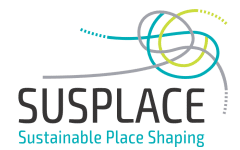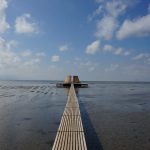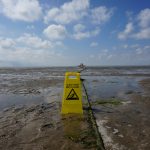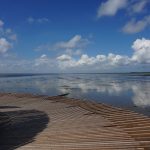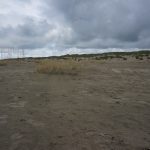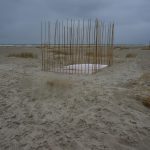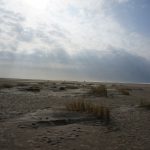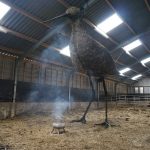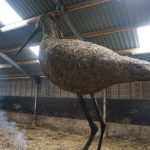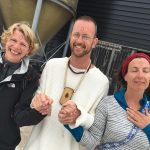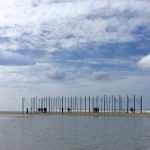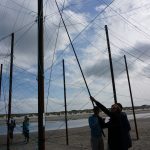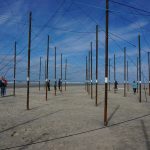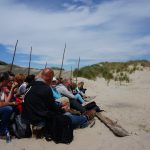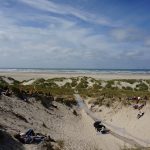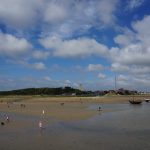
By Kelli Rose Pearson and Anke de Vrieze
We are standing in awe in the middle of a tidal sea, perched on a structure resembling a wooden spaceship-flower. Vast skies decorated with streaks of white and cotton candy clouds are mirrored in the water all around us. A light breeze tickles our faces with a fresh salty, umami scent. Flocks of sea birds swoop and cry in cacophonous harmony. Our feet are covered with rich clean sedimentary sea mud. We breathe deeply and feel at home in the landscape.
This was our first encounter with the art of the Oerol (“Everywhere”) Festival on Terschelling Island in the northern Netherlands. The installation, called Drie Streken (or “Three Directions”), was created by Marc Van Vliet to connect visitors to the rhythms of the surrounding nature – the tides, the moon, the movement of the planet, and the inhabitants and co-creators of the landscape – birds, crabs, sea grasses, fish of all kinds. It was only possible to reach the installation by walking, first through the tidal mud or shallow water, then via a narrow boardwalk that led 300 meters directly away from the land, directly south. The sculpture reacted kinetically to the changing tide, opening up “petals” as the tide comes in and changing the position of built-in benches. The central circle framed the speed of the rushing tide, giving focus to the constant, changing dynamic tidal ecosystem.
We had come to the island on an exploratory mission, testing the waters for research potential and inspiration related to the festival. Specifically, Kelli is interested in the role of art and cultural practices in stimulating place-based leadership and Anke is focused on the integration of experiential art and learning spaces, both with the aim of fostering mindsets of sustainability and care of place. Both of us are interested in innovative research methodologies and transdisciplinary, participant-involved approaches. Not only does art have the potential to expand the knowledge gathering and learning process to include subjective experience and move beyond traditional modalities, it also has potential to contribute to new ways of communicating research results and engaging people outside of academia.
The Oerol festival is widely considered one of the most innovative theater and arts festivals in the world, and its engagement with the natural environment has put it in the vanguard of a global movement integrating environmental themes with the arts. In fact, its position at the nexus of art, environment, and innovation contributed to the choice of the region of Leeuwarden as the European Capital of Culture 2018 beating out Utrecht, Maastricht, The Hague and Eindhoven for the Netherlands bid. The award is already being integrated into the festival. The Drie Streken installation, for example, was a partner of the EU Cultural Capital “Sense of Place” program, which gives funds and support to projects in line with their vision for fostering sense of place.
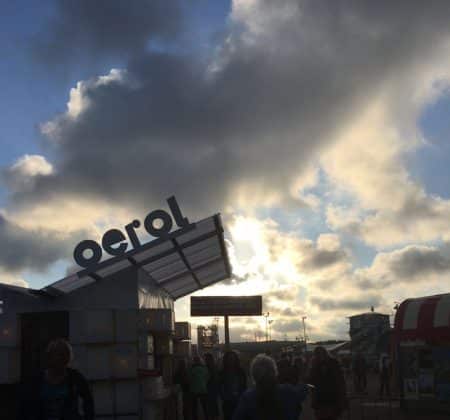
The mission of the festival is directly aligned with our underlying inquiry about how art can change our collective story/conceptual framework about human-nature relationships and our social imaginaries of sustainability. Approaching the fundamental question of our individual and collective human-nature relationship through the medium of the festival, Oerol director and founder Joop Mulder asks: Nature preservation or self-preservation? He sees the current iteration of the festival, with the emphasis on “Sense of Place” as an expression of the “understanding that, as a result of the constant presence of the human touch, Nature and Culture will be the next evolutionary step.”
As an entree to the festival, we were generously hosted by the Oerol Research Center coordinated by Rotterdam-based design studio Afdeling Buitengewone Zaken (Department of Extraordinary Affairs). Their aim is to develop a ‘research-unit’ that can provide creative input for participating artists and support the overall vision of the festival to become a ‘living laboratory’ exploring the interrelationship of ‘sense of place’ and ‘art.’ Afdeling Buitengewone Zaken assembled a group of four engaged and innovative design teams, each exploring a different research approaches. Graphic designer Ruiter Janssen worked together with Collectief Walden, capturing a snapshot of the audience’s mindset before and after the performance through associative words. Design Studio Knol worked together with dance company Club Guy & Roni on The Happiness Machine project. Their concept was designed to explore intrinsic versus extrinsic happiness and if appearance-based compliments and a “king of the world” feeling of being adored would make people feel happy. Afdeling Buitengewone Zaken developed a toolkit for theater maker Gienke Deuten, collecting moments of being moved at the festival through the active participation of visitors and residents. Lastly, theater maker Emke Idema led an “Unlearning Workshop” which consisted of a collective discussion of moments when people had a change of mindset or became open to a new perspective. These conversations were designed to provide input into her own future artistic works.
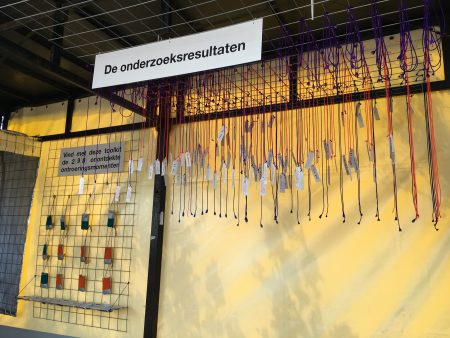
Overall, the research projects weren’t attempting to follow the standards of a formal scientific approach, but rather, as Celine de Waal Malefijt of Studio Knol put it, to provide interesting inputs into an ongoing conversation with the artists. They all recognized that purpose of their ‘research’ is quite different than it would be in an academic setting, and must be considered in this context. Their approach was exploratory, creative, and playful, and for them this first year was an experiment and a learning experience which will shape their designs for future research. In the next few weeks we will work together with Afdeling Buitengewone Zaken to map out and visualize the roles of art, participation, and research within each of their projects as a way of processing the experience and organizing feedback, reflections, and inputs for next year and for our own projects.
Content-wise, the projects associated with the Research Unit were only loosely connected to our core research topic (connecting art and sustainable place-shaping). Most aligned was the “Moving Moments” project which aimed to sensitize people to their place-based experiences and to recognize and expand their emotional connection to Terschelling. The “Unlearning Workshop” was connected to the process of mindset shift at a meta level, and although not explicitly linked to place-based ecological and social systems, Emke’s approach could be used as a tool for exploring mindsets of sustainability. In general, the projects did not focus directly on developing long-term relationships with place or with fostering mindsets or cultures of sustainability. Their leading-edge, original approach to researching the role and process of art, however, was educational and inspiring, as was their openness to evolving their approach and learning from experience and the input of others.
Beyond the Research Unit, however, there were a number of installations that thoughtfully connected people to the place, both in the short term, and with longer term visions for Terschelling (see description and photos of some our favorites below). In a sense, the installations could be considered a practice ground for connecting to place, for developing a heightened sensitization and ways of experiencing and participating with place. This mindset could be applied in any place which one takes the time and effort to connect with.
Finally, the actual infrastructure and set-up of the festival grounds reflected a coherence between stated and lived values that felt refreshing and authentic. Both of us are usually quite aware of and critical of glaring hypocrisies between words and actions, but the organizers of the Oerol took care of many details including recycling, food gardens in the restaurants, upcycled materials in construction, etc. Innofest, a network of Dutch festivals moving towards sustainable practices, hosted an area at one of the main stages dedicated to sustainability concepts for small local entrepreneurs and support for local businesses to increase their engagement and visibility with festival visitors.
Overall, the playful, exploratory, and aesthetic qualities of the research and of the art installations were inspiring. This open, beautifully creative, non-dogmatic, non-didactic approach to engaging with issues of human-nature made the topic accessible.
Following are some our favorite installations that were most relevant to the concept of re-imagining, re-experiencing culture-nature connections:
Windwerk by SLeM (Sense of Place Partner)
Windwerk is both an art installation and an ambitious dune formation experiment. The aim of the project was to create “a temporary landscape as a catalyst for innovative dune formation for the purpose of climate adaptation”As they describe: “inspired by the geometric metamorphosis drawings of M.C. Escher, this is a project in which dune formation processes become visible and are stimulated by the ‘dance’ between humans and nature.” The project brought together a coalition of scientists, volunteers, and government and non-profit organizations, including the department of nature conservation at Wageningen University. The set-up process included the active participation of volunteers, such as students from ELASA (European Landscape Architecture Student Association) in the physical restoration of the dunes.
Uw Kruidenrijk Kome (‘Thy Herbdom Come’) by Waterlanders (Sense of Place Partner)
This installation enticed with the mysterious description: “The polder is a battlefield, a market square, a nursery, and a hotel room for an hour. At the heart of the swirling mass of life and death is a temple. A sacred place where the universe of the polder is condensed. Enter this place with respect.”
We were warmly greeted as “sisters” by three men in white outfits, with cultish symbols on their foreheads and medallions carved with the shape of an egg. They initiated us with the symbol and led us to a barn where we were instructed to light some incense… cows were chewing cud in the background, a sound installation added to the gravitas of the ambiance. As we rounded the corner, we saw the object of worship – a giant (5 meter high) godwit bird made out of cow manure, standing majestically in front of an altar of incense and an area for contemplation. The success of the installation was in part due to the way it drew in the audience as co-conspirators and as fellow-actors in the parody. It also had the element of delight and discovery.
But the meaning behind it was more serious. The godwit is an endangered migratory bird, and also the national bird of the Netherlands. There is a strong connection between good dairy farming practices and habitat restoration in the form of highly biodiverse grazing meadows. The Installation brought attention to the connection between the bird and the cows and the “sacrality” of our interdependence. We had finally found a cult that we could join without hesitation!
Sea of Sand by FORESEA and TU Delft Landscape Architecture (Sense of Place Partner)
The Sea of Sand project was participatory/ social sculpture formed by participants answering questions related to climate change and marking their answers by stringing colored yarn between 60 poles representing the predicted rise of sea level on Terschelling – 6 meters by the year 2200. According to their brochure, “the Installation aims to create a dramatic visualization of possible future sea-level rise in a way that cannot be experienced by reading statistics alone.” They wanted to find out awareness levels and to connect visitors and residents to the intangible concept of sea level rise in a visceral, visual, interactive way. Not only was the project visually stunning, its appeal was the hands-on participation of the audience; throughout the ten days of Oerol, 6,000 people physically created the sculpture that was a 3-dimensional representation of their own opinions.
Car Pool: An example of the playful approach to sustainability at the Oerol Festival
Car Pool was literally a car that had been turned into a jazucci bath. The artist explained, with some humor, that he wanted younger people to have positive associations with “car pooling” so that later they are more likely to reduce traffic by sharing vehicles.
